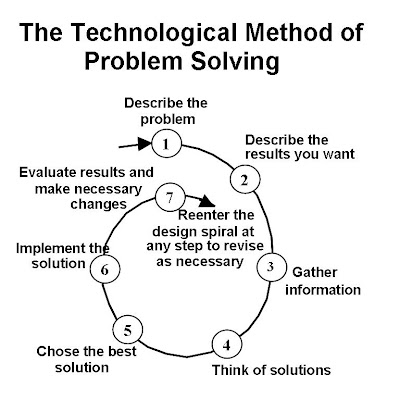Scientists, engineers, and ordinary people use problem solving each day to work out solutions to various problems. Using a systematic and iterative procedure to solve a problem is efficient and provides a logical flow of knowledge and progress.
In this unit, we use what is called "The Technological Method of Problem Solving." This is a seven-step procedure that is highly iterative - you may go back and forth among the listed steps, and may not always follow them in order. Remember that in most engineering projects, more than one good answer exists. The goal is to get to the best solution for a given problem
The Seven Steps of Problem Solving
1.Identify the problem
Clearly state the problem. (Short, sweet and to the point. This is the "big picture" problem, not the specific project you have been assigned.)
2.Establish what you want to achieve
Completion of a specific project that will help to solve the overall problem.
In one sentence answer the following question: How will I know I've completed this project?
List criteria and constraints: Criteria are things you want the solution to have. Constraints are limitations, sometimes called specifications, or restrictions that should be part of the solution. They could be the type of materials, the size or weight the solution must meet, the specific tools or machines you have available, time you have to complete the task and cost of construction or materials.
3.Gather information
Research
Research is sometimes needed both to better understand the problem itself as well as possible solutions.
Don't reinvent the wheel - looking at other solutions can lead to better solutions.
Use past experiences.
4. Brainstorm possible solutions
List and/or sketch (as appropriate) as many solutions as you can think of.
5. Choose the best solution
Evaluate solution by: 1) Comparing possible solution against constraints and criteria 2) Making trade-offs to identify "best."
6. Implement the solution
Develop plans that include (as required): drawings with measurements, details of construction, construction procedure.
Define tasks and resources necessary for implementation.
Implement actual plan as appropriate for your particular project.
7. Test and evaluate the solution
Compare the solution against the criteria and constraints.
Define how you might modify the solution for different or better results.
